Whenever two boats try to occupy the same water at the same time, a right of way situation exists. When this happens, one boat is obligated to give way to the other. The boat that is supposed to give way is Called the give way vessel and the other one is called the stand on vessel The stand on vessel should keep to its course so the skipper of the give way vessel can get out of the way without collision. There are specific rules to use in determining which vessel is which.
Motor vs. Sail: A motor boat is any vessel using an engine regardless of whether it is a sailboat or a motorboat. A sailboat is considered to be a motorboat even if the SailS are up as long as the engine is running. A sailboat that is sailing generally has the right of way over motorboats. But there are some exceptions.
Large motor vessels are given the right of way in channels where it is difficult for them to maneuver.
In narrow channels, motor vessels as small as 65 feet may be limited in maneuverability enough to make them the "stand on" vessel.
Motor vessels that are restricted in maneuverability due to the special job they are doing are "stand on" This could be anything from towing nets to dredging, pile driving, or tending buoys.
Motor vessels don't have to give way to sail boats that are motoring when the rules for motorboats give the motor vessel right of way. (When motoring, a sailboat is treated like any other motorboat.
If a motor vessel is experiencing some kind of difficulty restricting its maneuverability, it is given right of way.
If a sailboat is overtaking a power boat, the power boat has the right of way.
Passing - When any boat is passing another boat, the passing boat is tile give way boat and tile boat being passed is the stand on boat.
Head On - When two motor boats approach each other head on, both boats turn to the right and pass each other port to port.
Crossing - When motor boats paths cross, the boat on the other's right is stand on and the one on the other's left is the give way boat This is like two cars coming to a 4-way stop except that a give way boat would alter course to go behind the other boat
Sailboats - When encountering sailboats that are sailing, motorboats generally should give way. If you are motoring in a sailboat, you should give way to sailboats that are sailing.
Rules for Sailboats
Anytime Two Sailboats Are On Opposite Tacks - The Boat On Starboard Tack Has The Right Of Way
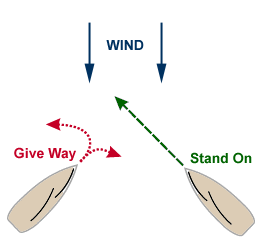
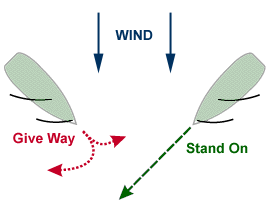
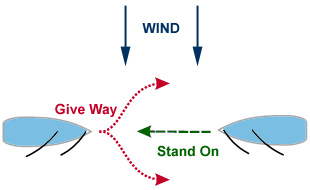
The Boat On Starboard Tack Has The Right Of Way
Anytime Sailboats Are on the Same Tack The Boat Most To Leeward Has Right of Way
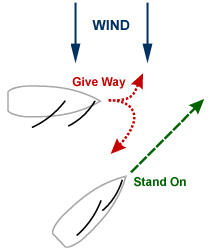
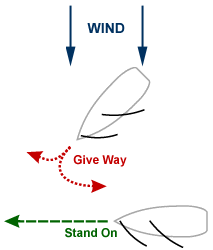
The Boat Most To Leeward Has Right of Way
Overtaking - The overtaking vessel should give way regardless of tack or whether sailing or motoring. The notable exception to this rule is in the case of large vessels that are confined to the channel due to draft. Even at minimum speed, ships usually move faster than sailboats, therefore you should keep an eye out behind your boat as well as ahead.
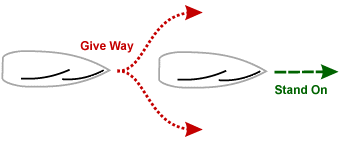
Overtaking Boats Give Way to Boats Being Overtaken
General Rules - Whenever there is a risk of collision and it appears that the give way boat is not taking appropriate action, it is the duty of the stand on boat to avoid the collision by altering course. Having the right of way is a poor excuse for having a collision - alterations in course to avoid a collision should be made obvious enough so that the other skipper can see what you are doing. Sometimes you can tell if you are on a collision course by the compass bearing to the other vessel. If the bearing remains steady, collision is imminent unless someone changes course. Sometimes it is difficult to see in all directions on a sailboat, especially when sailing close hauled. The jib can block 25% of view from the cockpit. The area of obstruction occurs on the leeward side from straight ahead to abeam. It just so happens that when you are close hauled or close reaching, sailboats close hauled or close reaching on the opposite tack will remain within this blind spot sometimes right until the time of collision. It's important to have a crew member keep an eye out to leeward when ever the jib obstructs your view.